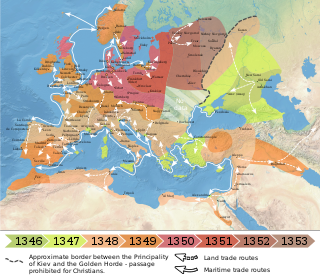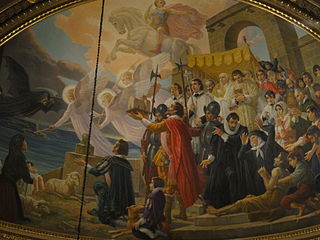 W
WIn 1563, London experienced its worst episode of plague during the sixteenth century. At least 20,136 people in London and surrounding parishes were recorded to have died of plague during the outbreak. Around 24% of London's population ultimately perished, but the plague affected London's insanitary parishes and neighborhoods the most.
 W
WFrom 1592 to 1593, London experienced its last major plague outbreak of the 16th century. During this period, at least 15,000 people died of plague within the City of London and another 4,900 died of plague in the surrounding parishes.
 W
WThe Black Death was a bubonic plague pandemic occurring in Afro-Eurasia from 1346–53. It is the most fatal pandemic recorded in human history, resulting in the deaths of up to 75–200 million people in Eurasia and North Africa, peaking in Europe from 1347 to 1351. Bubonic plague is caused by the bacterium Yersinia pestis, but it may also cause septicaemic or pneumonic plagues.
 W
WThe Black Death was one of the most devastating pandemics in human history, resulting in the deaths of an estimated 75 to 200 million people in Eurasia, and peaking in Eurasia from 1321 to 1353. Its migration followed the sea and land trading routes of the medieval world. This migration has been studied for centuries as an example of how the spread of contagious diseases is impacted by human society and economics.
 W
WThe crucifix of San Marcello is a medieval work of religious art that is venerated in the Oratory of Santissimo Crocifisso of the Church of San Marcello al Corso in Rome. Having survived a fire that destroyed the church in 1519, the crucifix was popularly believed to possess intercessory powers. During an epidemic of plague in 1522 the crucifix was carried in a procession through the city. According to popular belief at the time, the procession caused the plague to leave the neighborhoods through which the crucifix passed, and eventually to die out in Rome.
 W
WDuring the Great Plague of 1665 the area of Derby, England, fell victim to the bubonic plague epidemic, with many deaths. Some areas of Derby still carry names that record the 1665 visitation such as Blagreaves Lane which was Black Graves Lane, while Dead Man's Lane speaks for itself. It has been claimed by some historians that bodies were buried standing upright at St. Peter's Church, Derby, but this legend has been refuted by experts.
 W
WThe Great Plague of London, lasting from 1665 to 1666, was the last major epidemic of the bubonic plague to occur in England. It happened within the centuries-long Second Pandemic, a period of intermittent bubonic plague epidemics which originated from Central Asia in 1331, the first year of the Black Death, an outbreak which included other forms such as pneumonic plague, and lasted until 1750.
 W
WThe Great Plague of Marseille was the last major outbreak of bubonic plague in western Europe. Arriving in Marseille, France in 1720, the disease killed a total of 100,000 people: 50,000 in the city during the next two years and another 50,000 to the north in surrounding provinces and towns.
 W
WThe Great Plague of Vienna occurred in 1679 in Vienna, Austria, the imperial residence of the Austrian Habsburg rulers. From contemporary descriptions, the disease is believed to have been bubonic plague, which is caused by the bacterium Yersinia pestis, carried by fleas associated with the black rat and other rodents. The city was crippled by the epidemic, which recurred fitfully into the early 1680s, claiming an estimated 76,000 residents.
 W
WThe Italian Plague of 1629–1631 was a series of outbreaks of bubonic plague that ravaged northern and central Italy. This epidemic, often referred to as the Great Plague of Milan, claimed possibly one million lives, or about 25% of the population. This episode is considered one of the later outbreaks of the centuries-long pandemic of bubonic plague that began with the Black Death. The plague may have contributed to the decline of Italy's economy relative to that of other Western European countries.
 W
WLoimologia, or, an historical Account of the Plague in London in 1665, With precautionary Directions against the like Contagion is a treatise by Dr. Nathaniel Hodges (1629–1688), originally published in London in Latin in 1672; an English translation was later published in London in 1720. The treatise provides a first-hand account of the Great Plague of London; it has been described as the best medical record of the epidemic. While most physicians fled the city, including the renowned Thomas Sydenham, and Sir Edward Alston, president of the Royal College of Physicians, Hodges was one of the few physicians who remained in the city during 1665, to record observations and test the effectiveness of treatments against the plague. The book also contains statistics on the victims in each parish.
 W
WThe 1592–1593 Malta plague epidemic was a major outbreak of plague on the island of Malta, then ruled by the Order of St John. It occurred in three waves between June 1592 and September 1593, during the second plague pandemic, and it resulted in approximately 3000 deaths, which amounted to about 11% of the population. The disease was imported to Malta by Tuscan galleys that had captured vessels from Alexandria. In 1593, the Order requested assistance from Sicily to deal with the epidemic, and the measures taken were effective in containing plague.
 W
WThe 1675–1676 Malta plague epidemic was a major outbreak of plague on the island of Malta, then ruled by the Order of St John. It occurred between December 1675 and August 1676, and it resulted in approximately 11,300 deaths, making it the deadliest epidemic in Maltese history. Most deaths were in the urban areas, including the capital Valletta and the Three Cities, which had a mortality rate of about 41%. In the rural settlements, the mortality rate was 6.9%.
 W
WThe 1813–1814 Malta plague epidemic was the last major outbreak of plague on the islands of Malta and Gozo. It occurred between March 1813 and January 1814 on Malta and between February and May 1814 on Gozo, and the epidemic was officially declared to be over in September 1814. It resulted in approximately 4500 deaths, which was about 5% of the islands' population.
 W
WMarian columns are religious monuments depicting Virgin Mary on the top, often built in thanksgiving for the ending of a plague or for some other reason. The purpose of the Holy Trinity columns was usually simply to celebrate the church and the faith, though the plague motif could sometimes play its role in their erection as well. Erecting religious monuments in the form of a column surmounted by a figure or a Christian symbol was a gesture of public faith that flourished in the Catholic countries of Europe especially in the 17th and 18th centuries. Thus they became one of the most visible features of Baroque architecture. This usage also influenced some Eastern Orthodox Baroque architecture.
 W
WPlague Riot was a riot in Moscow in 1771 between September 15 and September 17, caused by an outbreak of bubonic plague.
 W
WThe Naples Plague refers to a plague in Italy between 1656–1658 that nearly eradicated the population of Naples. The plague epidemic affected mostly central and southern Italy, killing up to 1,250,000 people throughout the Kingdom of Naples according to some estimates. In Naples alone, approximately 150,000–200,000 people died in 1656 due to the plague, accounting for more than half of the population. The epidemic made severe impact on the economic and social structure of Naples as well as some other affected areas.
 W
WThe 1812–1819 Ottoman plague epidemic was one of the last major epidemics of plague in the Ottoman Empire. This particular epidemic would cost the lives of at least 300,000 individuals. Plague epidemics occurred frequently in the Ottoman Empire between the 16th and 19th centuries.
 W
WMarian columns are religious monuments depicting Virgin Mary on the top, often built in thanksgiving for the ending of a plague or for some other reason. The purpose of the Holy Trinity columns was usually simply to celebrate the church and the faith, though the plague motif could sometimes play its role in their erection as well. Erecting religious monuments in the form of a column surmounted by a figure or a Christian symbol was a gesture of public faith that flourished in the Catholic countries of Europe especially in the 17th and 18th centuries. Thus they became one of the most visible features of Baroque architecture. This usage also influenced some Eastern Orthodox Baroque architecture.
 W
WThe Plague Column or Immaculata is a Baroque plague column in Košice, Slovakia.